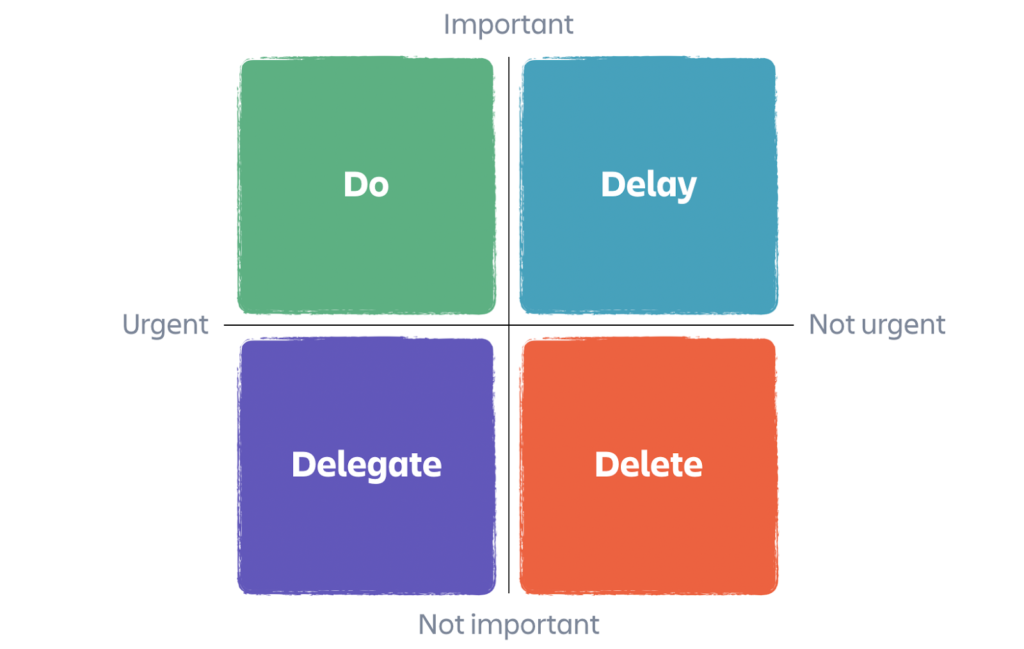Time Management Foundations – Making Smarter Choices with the 4 D’s
Why Time Management is Really About Decision-Making
Time management isn’t just about working faster or fitting more tasks into your schedule. It’s about making smarter decisions about how you use your time. Every day, professionals juggle emails, meetings, deadlines, and unexpected requests – all demanding attention. Without a clear way to prioritize, it’s easy to feel constantly busy but not truly productive.
If you’ve ever felt overwhelmed by your to-do list, the problem isn’t necessarily how much work you have – it’s how you decide what to focus on. Successful time management isn’t just about planning your day; it’s about making deliberate choices about which tasks to tackle, which to delay, which to delegate, and which to eliminate altogether.
That’s where the 4 D’s of Time Management come in.
The Challenge of Overload: Why We Need a Smarter Way to Prioritize
Most professionals start their day with good intentions – maybe even a carefully planned to-do list. But as soon as emails, meeting requests, and unexpected tasks roll in, that plan goes out the window.

- We respond to urgent requests instead of focusing on important work.
- We jump between tasks, never really finishing anything.
- We waste time on low-value activities because we don’t have a system for deciding what truly matters.
This constant decision fatigue drains our energy, creates stress, and leads to burnout. But what if you had a simple, repeatable framework to quickly categorize and prioritize every task that comes your way?
The 4 D’s: A Smarter Way to Make Decisions
The 4 D’s of Time Management provide a structured approach to task decision-making, helping you move from reactive work to intentional productivity.
Instead of tackling tasks randomly, you filter them into four categories:

- Do – Tasks that are urgent and important, requiring immediate action.
- Defer – Tasks that are important but not urgent, which should be scheduled for later.
- Delegate – Tasks that need to be completed but can be assigned to someone else.
- Delete – Tasks that don’t contribute to your goals and should be eliminated.
When you apply this system consistently, you stop feeling overwhelmed and start managing your time with purpose.
Real-World Scenarios: How Smart Decisions Improve Productivity
To see how this works in real life, let’s look at a few common workplace scenarios:
1. Managing an Overflowing Email Inbox
Imagine you start your day with 50+ unread emails. Without a strategy, you might waste an hour reading everything – only to realize most of it wasn’t urgent.

Applying the 4 D’s:
✅ Do – Respond immediately to emails requiring urgent action.
⏳ Defer – Flag non-urgent emails and schedule time to address them later.
📤 Delegate – Forward requests better handled by someone else.
🗑 Delete – Remove spam, newsletters, or irrelevant messages.
Outcome: Instead of getting lost in your inbox, you focus on high-value emails and reduce unnecessary distractions.
2. Handling Last-Minute Meeting Requests
A colleague asks you to join a meeting you weren’t expecting. Should you say yes?

Applying the 4 D’s:
✅ Do – If your input is critical, attend and contribute.
⏳ Defer – If the meeting isn’t urgent, ask to reschedule.
📤 Delegate – If someone else from your team can represent you, send them instead.
🗑 Delete – If the meeting isn’t relevant, politely decline.
Outcome: You attend only the meetings that truly need your input, freeing time for deep work.
3. Prioritizing a Long To-Do List
At the start of the week, you have 20+ tasks to complete. Where do you begin?

Applying the 4 D’s:
✅ Do – Start with high-priority, time-sensitive tasks.
⏳ Defer – Schedule important but non-urgent tasks later in the week.
📤 Delegate – Pass along tasks that others can handle.
🗑 Delete – Remove low-impact tasks that don’t align with your goals.
Outcome: You focus on what truly moves the needle, instead of drowning in busywork.
Download the Free Tool: 4 D’s of Time Management Worksheet
If you’re ready to stop feeling overwhelmed and start making smarter time management decisions, download my 4 D’s of Time Management Worksheet.
This tool will help you:
✔ Apply the 4 D’s to your workload.
✔ Use a decision-making flowchart to quickly categorize tasks.
✔ Eliminate low-value work and focus on what truly matters.
Final Thoughts: Make 2025 the Year of Smarter Time Management

Most people don’t struggle with time management because they lack time – they struggle because they don’t have a system for making smart choices.
By using the 4 D’s, you can start taking control of your workload instead of letting it control you. Small changes in how you prioritize tasks can create massive improvements in your productivity and reduce stress.
Try it for a week – see what happens when you stop reacting and start managing your time intentionally.
And don’t forget to download the free worksheet to make this strategy part of your daily routine!